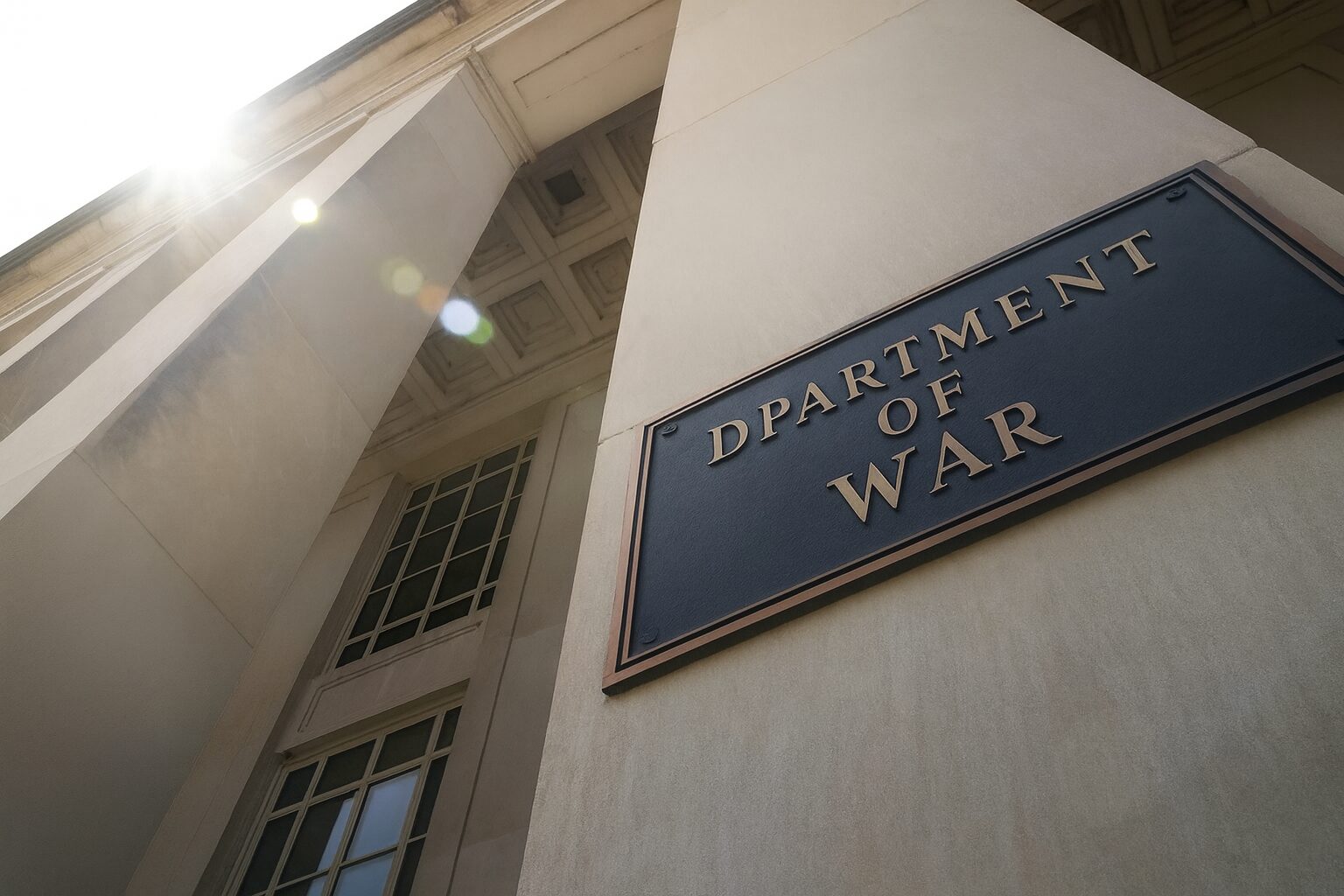A Stark Return to a Historic Name
In a move that has stunned Washington and reverberated across global capitals, President Donald Trump has signed an executive order rebranding the U.S. Department of Defense as the “Department of War.” The change revives a name used from the nation’s founding in 1789 until 1949, when it was abandoned in favor of the more restrained “Defense” moniker.
Under the order, Defense Secretary Pete Hegseth now carries the title “Secretary of War,” and other top Pentagon leaders have seen their designations similarly altered. While the shift remains largely symbolic until Congress passes formal legislation, the administration has already begun the process of institutionalizing the name by changing signage, preparing new letterheads, and pushing bills to codify the rebrand.
For Trump, who has repeatedly sought to stamp his imprint on America’s political institutions, the renaming represents both a symbolic flourish and a signal of intent. Supporters see it as a restoration of America’s “warrior ethos.” Critics argue it is little more than costly theatrics, with the potential to stoke unnecessary aggression abroad.
What’s Driving the Renaming?
The historical context of the name is crucial. The Department of War defined U.S. military power for 160 years, a period that spanned the Revolutionary War, the Civil War, and two World Wars. After 1949, the Truman administration deliberately adopted “Department of Defense” to reflect a post–World War II emphasis on deterrence, alliance-building, and diplomacy, rather than an openly offensive stance.
Trump and his allies contend that the softer language of “defense” has diluted America’s strength. “As Department of War, we won everything. I think we’re going to have to go back to that,” Trump declared in a recent speech. Hegseth has echoed the message, renaming his Pentagon briefing space the “W.A.R. Room” in a theatrical nod to the rebrand.
To supporters, the change underscores readiness, resolve, and deterrence through unapologetic strength. To critics like Democratic Senator Tammy Duckworth, the name change is wasteful posturing. “We’re talking about millions of dollars in signage, logistics, and bureaucracy just to stoke a culture war,” she said, pointing to the fact that the armed forces already face budget constraints that affect housing, healthcare, and readiness for military families.
“War, Not Defense”: The Political and Cultural Signal
The renaming is about more than semantics. It projects a philosophical pivot: America as a nation that acts offensively, rather than defensively.
Political analysts suggest Trump’s rebrand is designed to shift the culture of U.S. foreign policy away from what he derides as “weak diplomacy” and toward visible militarism. The very word “war” sends an unmistakable message, both at home and abroad. To supporters, it says the United States is no longer interested in half-measures. To opponents, it risks escalating conflicts by telegraphing aggression even when diplomacy might serve better.
Symbols matter in geopolitics. When the Pentagon projects itself as a “Department of War,” adversaries and allies alike adjust their calculations. For countries wary of U.S. dominance, the name change confirms fears of an America more eager to strike than to negotiate.
Escalating Military Pressure in the Caribbean
The clearest test of this “Department of War” ethos has already played out in the Caribbean. Over the summer of 2025, U.S. forces increased their naval presence off the coast of Venezuela, citing the need to dismantle drug cartels that operate maritime smuggling routes.
On September 2, a U.S. naval strike sank a vessel allegedly tied to the Tren de Aragua cartel, killing 11 people. Administration officials called it a decisive blow against transnational crime. Critics, however, noted that the action took place in contested international waters, raising questions about legality under the War Powers Resolution and international maritime law.
The message from Washington was unambiguous: the United States is willing to take lethal action swiftly, even in gray zones of international authority. Legal scholars warn that this posture sets a precedent for unilateral military action without congressional authorization or international sanction, further eroding long-standing norms.
Flashpoints Near Ukraine: High Tensions, Thin Hope
Beyond the Caribbean, the renaming intersects with another flashpoint: Ukraine. Russian President Vladimir Putin recently warned that any foreign troop deployments to Ukraine would be considered “legitimate targets.” Against that backdrop, the “Department of War” label raises anxieties that the U.S. is embracing confrontation over deterrence.
Western nations are already walking a tightrope between aiding Ukraine and avoiding direct conflict with Russia. A Pentagon that defines itself explicitly in terms of war amplifies fears of escalation. Even symbolic shifts can influence the delicate balance of deterrence, where misperceptions and rhetoric often carry real-world consequences.
Symbolism with Costs
On the surface, the renaming seems like a branding exercise. But symbolism carries real costs. Implementing the change requires sweeping logistical updates such as new insignia, websites, digital infrastructure, building signage, uniforms, and formal seals. Analysts estimate the transition could cost hundreds of millions of dollars.
Critics argue those funds could be better directed toward improving living conditions for service members, strengthening diplomatic capacity, or investing in modern cyber and space defense systems. Instead, money is being funneled into what some describe as “performative militarism.”
Warrior vs. Defender: The Philosophical Pivot
At its core, the rebrand highlights a battle of narratives. The “Department of Defense” reflected a philosophy of guarding borders, preserving alliances, and avoiding unnecessary conflict. The “Department of War” reframes that identity, encouraging an offensive mindset that elevates combat readiness above all else.
This is more than political branding. It is a redefinition of how the U.S. military sees itself and how the world sees it. For service members, it could reshape culture, expectations, and doctrine. For adversaries, it signals a nation prepared to act with force first and justify later.
Military Muscle, Global Ripples
Already, the ripple effects of the rebrand are evident. In the Caribbean, lethal strikes blur the line between policing and warfare. In Eastern Europe, allies and adversaries weigh the meaning of America’s symbolic turn. In Asia, where tensions with China remain high, the optics of a “Department of War” could further strain already fragile relations.
Diplomats warn that America’s allies, long accustomed to balancing reassurance with deterrence, may find it harder to defend U.S. actions when they carry the banner of “war.” Meanwhile, adversaries may use the new label as propaganda to depict America as an aggressor, fueling anti-U.S. sentiment in regions already wary of interventionism.
Conclusions: Style Over Strategy?
Trump’s renaming of the Pentagon is more than a superficial gesture. It is a reflection of his broader worldview: that strength comes from projecting dominance, not compromise; from war, not defense.
Yet the risks are considerable. Symbolism can harden into policy. Words can escalate tensions. And costly rebrands can sap resources from real strategic needs.
Whether this move represents bold clarity or reckless bravado will depend on how the administration follows through. For now, America has traded “defense” for “war”, a change that may prove less about history and more about the future, one where confrontation overshadows consensus.
The world is watching to see if the United States is reclaiming its historic might– or stumbling into a more perilous age of endless conflict.

